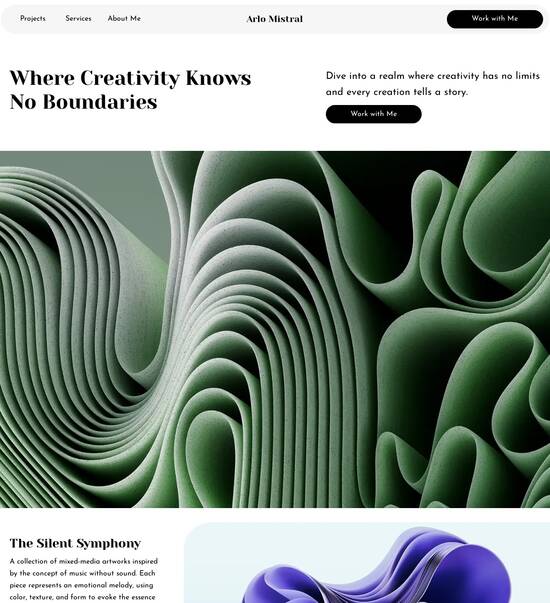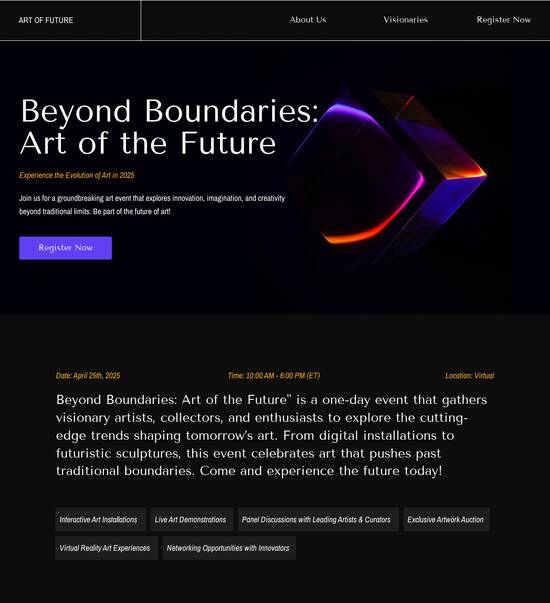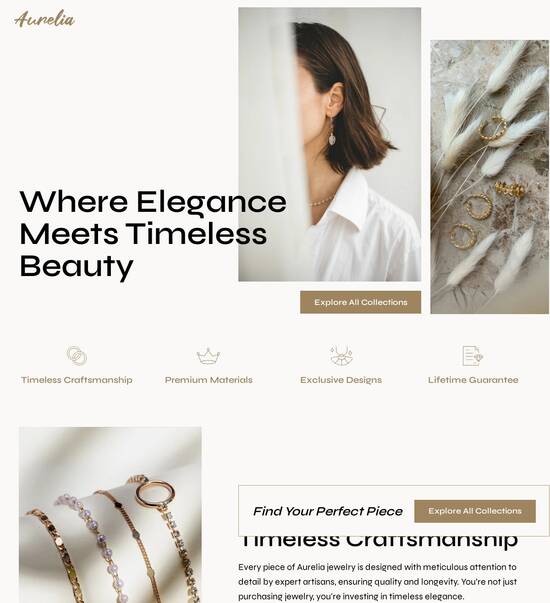
Material design HTML page templates
Use TemplateAbout template
Master the art of web design with material design HTML page templates. Transform your business today!
Recommended templates

Easy to build without coding
With the intuitive drag-and-drop builder, anyone on your team can create high-converting pages without any knowledge of code or design. Make enhancements to your landing page with custom widgets using Javascript, HTML/CSS, or third-party scripts.

Multiple layouts for any industry and goal
Select from 500+ landing page layouts built to boost conversions across industry-specific scenarios. Customize them by adjusting fonts, adding images, and generating on-brand content with the AI assistant. Quickly scale with Instablocks® and Global Blocks that you can save, reuse, and update globally.

Loads fast and looks polished on any device
Every template is responsive, which means they present professionally on any device and load blazingly fast with our Thor Render Engine. You can also power them up with Google AMP technology to deliver an unparalleled mobile experience and drive higher conversions.

Robust analytics & experimentation
Get real-time updates and reporting across all your devices, showing the number of visitors, conversions, cost-per-visitor, and cost-per-lead. Launch AI-powered experiments, run A/B tests, and use heatmaps to analyze user behavior, then optimize your landing page to maximize conversions.







Easy to build without coding
With the intuitive drag-and-drop builder, anyone on your team can create high-converting pages without any knowledge of code or design. Make enhancements to your landing page with custom widgets using Javascript, HTML/CSS, or third-party scripts.
Multiple layouts for any industry and goal
Select from 500+ landing page layouts built to boost conversions across industry-specific scenarios. Customize them by adjusting fonts, adding images, and generating on-brand content with the AI assistant. Quickly scale with Instablocks® and Global Blocks that you can save, reuse, and update globally.
Loads fast and looks polished on any device
Every template is responsive, which means they present professionally on any device and load blazingly fast with our Thor Render Engine.
Robust analytics & experimentation
Get real-time updates and reporting across all your devices, showing the number of visitors, conversions, cost-per-visitor, and cost-per-lead. Launch AI-powered experiments, run A/B tests, and use heatmaps to analyze user behavior, then optimize your landing page to maximize conversions.
All the features you need to build google material design website template
Explore more featuresLearn how to build material design web template
Frequently asked questions about material website template
Leading the way in building high-performing landing pages





Google material design website examples: Your ultimate how-to guide
In the competitive landscape of digital marketing in the USA, using an effective landing page is essential to drive conversions. With Instapage, you can access powerful tools to optimize your campaigns without breaking the bank. This guide will walk you through the steps of leveraging Instapage’s features to create landing pages that not only attract but also convert.
Understanding the Basics of Landing Pages
A landing page serves as the critical interface between your ad and your audience. It focuses on a specific action you want users to take, whether it's signing up for a newsletter, downloading a resource, or making a purchase. To maximize effectiveness:
- Clear Call-to-Action (CTA): Make your CTA prominent for visitors to know exactly what to do next.
- Engaging Design: Use high-quality visuals and simplified layouts to create a visually appealing experience.
- Targeted Content: Tailor your messages to specific audience segments to improve relevance and connection.
Step 1: Choose a Template
Start your journey with Instapage by selecting one of over 100 professionally designed, conversion-focused templates. The variety allows you to find a layout that suits your campaign needs while ensuring responsiveness across devices. Templates come with built-in lead generation elements that facilitate immediate results.
Step 2: Customize Your Page
With the intuitive drag-and-drop builder, customizing your landing page becomes a breeze.
- Text Editing: Easily modify the copy to reflect your brand's voice.
- Image and Video Integration: Embed multimedia content to enhance engagement.
- Dynamic Text Replacement: Personalize your content based on what led visitors to your page.
Step 3: Optimize for Conversions
Once your page is set, utilize Instapage's built-in features to optimize for maximum conversions.
- A/B Testing: Experiment with different headlines and layouts to find what works best.
- Heatmaps: Analyze user interactions to understand where attention is focused.
- Analytics Dashboard: Assess performance metrics to adjust strategies as needed.
By following these steps, you can build landing pages that not only attract but also engage and convert your audience effectively.
Ready to elevate your marketing efforts? Start your free trial with Instapage today and experience the difference in your conversion rates.
People also ask about material template free download
Material design HTML page templates: Transforming web interfaces
Understanding material design: An overview of the design philosophy
Material design is a design philosophy introduced by Google, focused on creating a cohesive and intuitive user experience across all digital platforms. Originating in 2014, its main objective is to elevate the functionality of designs while also enhancing the aesthetic appeal. Google sought to provide designers and developers with a unified set of guidelines that are visually compelling and easy to implement. The principles of material design are deeply rooted in physical materials and their behaviors, emphasizing how users interact with design in real life.
The core tenet of material design revolves around using tangible elements to create a more accessible UI. This approach has become increasingly relevant, as users expect their online experiences to mirror the behaviors and aesthetics of the physical world. Modern web aesthetics thrive on the balance of usability and creativity, and material design fulfills this need by allowing presentations that are both attractive and easy to navigate.
Origins and development by Google: A strategic move to enhance usability.
Key principles and objectives: Aiming for intuitive user experiences.
Relation to modern web aesthetics and usability: Blending form with function.
Exploring HTML5 templates within the material design system
HTML5 is a markup language specifically designed for structuring web content, providing developers with a robust framework to create engaging, interactive, and dynamic websites. Utilizing HTML5 templates comes with numerous advantages, including simplified coding processes and improved media handling capabilities. Beyond its structural advantages, HTML5 also supports responsive and adaptive designs, making it an excellent choice for modern websites that often cater to users on various devices.
By integrating material design principles into HTML5 templates, developers can benefit from a cohesive layout and design workflow. These templates are typically structured to facilitate the easy adoption of style guides, reducing the burden of creating unique designs from scratch. From navigation menus to images and interaction elements, the use of established material design frameworks within HTML5 ensures that web projects remain user-centered, effective, and visually distinctive.
Overview of HTML5 as a markup language: Foundation for modern web design.
Benefits of using HTML5 for modern website designs: Streamlined coding and enhanced multimedia support.
Specifics on compatibility with various devices: Ensuring smooth user experiences on all platforms.
Key features of material design HTML page templates
One of the standout attributes of material design HTML page templates is their focus on responsive design elements. With the advent of mobile devices, businesses must prioritize mobile-first designs that adapt elegantly to different screen sizes. This necessity drives developers to ensure that their layouts, images, and interactive features stretch, shrink, or reorganize in real time, enhancing the overall usability of a site.
Furthermore, the adaptability of these templates allows for a seamless integration of custom styles, ensuring that the design remains consistent with brand identities, regardless of specific usability requirements. Performance optimization becomes essential as well, as developers must balance visuals with load times to prevent user frustrations.
Importance of mobile-first design in today’s digital age: Adapting to user behaviors.
Techniques to ensure scalability across devices: Flexbox and grid systems.
Performance optimization considerations: Keeping load times minimal.
Another important feature of material design HTML page templates is their customizable components. Standard UI components such as buttons, cards, and sliders come predefined, allowing designers to modify them per their requirements. Using these predefined elements can significantly speed up the design process, as they eliminate the need to start from scratch, while still allowing for distinct creativity.
The developer's toolkit: Building with material design HTML templates
There are several prominent frameworks and libraries that support material design, each offering unique features for further development. Frameworks like Materialize, Vuetify, and Angular Material provide extensive UI components that are easy to implement and modify. These libraries support rapid development cycles, making it easier for developers to integrate material design principles into their projects seamlessly.
To incorporate these frameworks into existing projects, developers typically follow these steps: first, they select the framework that best suits their project needs. Next, they include its CSS and JavaScript files into the project. This step is followed by customizing components using the framework’s classes and data attributes. Finally, developers can test interactions and styles to ensure functionality and appearance meet their standards.
A review of prominent frameworks supporting material design: Materialize, Vuetify, Angular Material.
Steps for integrating these frameworks into new or existing projects: Using structured approaches.
Custom implementation of UI components for unique projects.
Advantages of using material design HTML templates
One notable advantage of material design HTML templates is the enhanced user experience and usability they provide. These designs simplify navigation using familiar patterns that users have come to recognize, reducing the learning curve for new visitors. The visual hierarchy created through material design principles allows for more intuitive interactions, keeping users engaged while minimizing frustration.
Beyond usability, the time efficiency in development becomes a crucial factor. By utilizing ready-made templates, developers not only save time but also streamline the coding process, significantly reducing the need for repetitive tasks. This approach allows for faster iterations and prototype development, ensuring that ideas can be tested and optimized before being fully implemented.
Enhanced user experience: Intuitive navigation and interaction patterns.
Time-saving aspects of using ready-made templates: Efficiency in development.
Boosting aesthetic appeal and brand identity: Consistency in design.
Real-world applications: Case studies of material design HTML templates
Material design HTML templates are particularly advantageous in various industries, with significant applications in e-commerce websites. The combination of engaging visuals and user-friendly interactions improves shopping experiences, allowing customers to navigate effortlessly through products. Notable examples include e-commerce shops that utilize material design to enhance their digital storefronts, leading to increased sales and customer satisfaction.
Similarly, portfolio and personal websites can effectively leverage material design templates. These designs offer a sophisticated way to display talent and projects, maximizing the impact of visuals and promoting effective branding. In corporate environments, or for blogs, aligning company branding with material design yields professional results, enhancing content organization and readability, which is vital for retaining audience attention.
E-commerce websites: Improving customer journeys through effective element placement.
Portfolio and personal websites: Showcasing talent effectively.
Corporate websites and blogs: Enhancing professionalism and readability.
Future trends and innovations in material design
Looking ahead, the integration of emerging technologies with material design principles will shape the future of web interfaces. The convergence of artificial intelligence and machine learning within UI/UX design holds the potential to create personalized user experiences that are tailored to individual preferences and behaviors. As the technology landscape evolves, the principles of material design may adapt to accommodate these advancements, ensuring designs remain relevant and effective.
Moreover, community contributions and open-source resources play a significant role in the evolution of material design templates. As more designers share their creations and innovations, the accessibility of high-quality design resources increases. This collaborative approach fosters creativity and encourages adherence to best practices, elevating the quality and consistency of material design applications across various platforms.
Emerging technologies and material design: AI for personalized user experiences.
Future directions for material design principles: Adapting to technological advancements.
The rise of community-driven material design toolkits and templates: Enhancing accessibility.
Lessons from implementing material design HTML templates
While implementing material design HTML templates, there are several common pitfalls to be aware of. Designers may find themselves overcomplicating designs that lead to user confusion, losing the user-centric focus that material design advocates. Inconsistent application of design principles can detract from the overall experience, and failure to consider performance implications due to heavy design elements can lead to frustrating user interactions.
Key takeaways for aspiring designers include the importance of continuous learning and adaptation in design practices. Balancing innovation with usability principles will ensure that the designs are not only appealing but also effectively serve user needs. Engaging with the design community provides ongoing inspiration and guidance, helping designers stay updated on trends and best practices.
Common pitfalls to avoid: Simplifying designs and maintaining user focus.
Key takeaways for aspiring designers: Continuous learning and adaptation.
Engaging with the design community: Sharing insights and inspiration.
Ready to skyrocket conversions?
Supercharge your ad campaigns with high-performing landing pages
Get started














